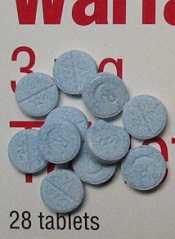
ROME—The novel oral anticoagulant edoxaban is a feasible treatment option for patients with atrial fibrillation (AF) who need anticoagulation before cardioversion, according to researchers.
Results of the ENSURE-AF trial suggest edoxaban is “an effective and safe alternative” to standard therapy with warfarin and enoxaparin and may allow for prompt cardioversion with transesophageal echocardiography (TEE), said Andreas Goette, MD, of St. Vincenz-Hospital in Paderborn, Germany.
“These results may have important clinical implications for newly diagnosed, non-anticoagulated AF patients undergoing cardioversion,” Dr Goette noted.
“According to the study protocol, a newly diagnosed, non-anticoagulated AF patient was started on edoxaban, and the cardioversion procedure was scheduled as early as 2 hours following the start of treatment, when applying a TEE-guided approach.”
Dr Goette presented results from ENSURE-AF at ESC Congress 2016 (abstract 5715). The data were simultaneously published in The Lancet. The study was supported by Daiichi Sankyo.
This phase 3b study included 2199 patients with documented non-valvular AF who were scheduled for electrical cardioversion after anticoagulation therapy.
Patients were randomized to receive edoxaban (n=1095) or warfarin with enoxaparin bridging (n=1104). Edoxaban was dosed at 60 mg once daily, but the dose was reduced to 30 mg if one or more of the following factors were present: renal impairment, low body weight, or concomitant use of certain P-glycoprotein inhibitors.
Patients were stratified according to the cardioversion approach (TEE or non-TEE), a patient’s prior experience taking anticoagulants at the time of randomization (ie, anticoagulant-experienced or naïve), and edoxaban dose (60 mg or 30 mg). Patients were randomized in a 1:1 ratio to 2 treatment groups within each stratum.
The primary efficacy endpoint was the composite of stroke, systemic embolic event, myocardial infarction, and cardiovascular death at day 28.
This endpoint occurred at a comparable rate in both treatment arms—0.5% in the edoxaban arm and 1.0% in the enoxaparin/warfarin arm (odds ratio [OR]=0.46; 95% CI, 0.12–1.43).
The primary safety endpoint was the composite of major and clinically relevant non-major bleeding events at 30 days.
This endpoint also occurred at a comparable rate in both arms—1.5% in the edoxaban arm and 1.0% in the enoxaparin/warfarin arm (OR=1.48; 95% CI, 0.64–3.55).
The result for the net clinical outcome—a composite of stroke, systemic embolic event, myocardial infarction, cardiovascular mortality, and major bleeding—was 0.7% in the edoxaban arm and 1.4% in the enoxaparin/warfarin arm (OR=0.50; 95% CI, 0.19–1.25) during the overall study period.
The researchers said the ORs recorded in this trial should be viewed with caution because the trial was not adequately powered to show statistically significant differences for efficacy or safety endpoints.
Still, the team said the results suggest edoxaban can provide an alternative to standard therapy.
“At a practical level, our study results show that newly diagnosed, non-anticoagulated AF patients can start edoxaban as early as 2 hours prior to their cardioversion procedure if they have access to [TEE] or 3 weeks prior without,” Dr Goette said.


